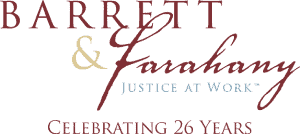Sexual harassment in the workplace is a serious issue, but what happens when the perpetrator isn’t a co-worker or supervisor, but a client or customer? The reality is that harassment from clients or customers is a troubling scenario that many employees face, often leaving them unsure of how to respond or where to turn for help.
The sexual harassment attorneys at Barrett & Farahany designed this guide to equip employees with the knowledge and steps to address such situations effectively. We’ll discuss what sexual harassment is, how to handle it when it happens, and what role employers play in creating a safe work environment. By understanding the rights, responsibilities, and resources available, employees and employers alike can work together to foster a respectful and harassment-free workplace.
What is Sexual Harassment?
Sexual harassment is any unwelcome sexual behavior that creates an intimidating, hostile, or offensive work environment. This can include inappropriate comments, advances, or physical conduct. While sexual harassment is most commonly discussed in the context of co-workers or supervisors, it can also come from clients or customers, particularly in roles where employees interact with the public regularly.
Ignoring harassment from clients or customers sends the message that employees’ safety and well-being are less important than maintaining business relationships. This can lead to a toxic workplace culture, high turnover rates, and potential legal repercussions for the employer. Addressing this issue head-on is essential for protecting employees and ensuring a professional, safe work environment.
Understanding the Problem
Common Scenarios of Harassment from Clients or Customers
Employees across industries – the restaurant industry, for example – report instances of inappropriate comments, unwanted advances, or even physical harassment from clients or customers. Some common scenarios include:
- Retail workers dealing with inappropriate remarks while assisting customers.
- Service staff being subjected to unwelcome attention during interactions.
- Employees at conferences or events face inappropriate advances during networking sessions.
These situations can put employees in a difficult position, balancing their professional roles with the need to protect themselves from harm.
Impact on Employees and the Workplace
The repercussions of harassment from clients or customers go beyond the individual — it affects morale, productivity, and workplace culture. Employees experiencing harassment often feel stress, anxiety, and a loss of confidence.
This can lead to burnout, decreased job satisfaction, and even career shifts. Employers are also at risk of reputational damage and legal liability if they fail to address such incidents adequately.
Steps for Employees to Take
If you experience harassment from a client or customer, acting promptly can help ensure your safety and protect your rights.
- Responding in the Moment (If Safe): If you feel safe, calmly tell the harasser their behavior is unwelcome and must stop. Assertive communication can sometimes deter further inappropriate behavior. For example, you might say, “I find that comment inappropriate; please stop.”
- Document the Incident: Keep a detailed record of the harassment. Document the date, time, location, specific actions or words, and any witnesses present. These notes will be essential for reporting the incident and, if necessary, pursuing further action.
- Report to Your Supervisor or HR: Notify your supervisor or Human Resources department as quickly as possible. Many organizations have clear anti-harassment policies in place and will guide you through the next steps.
- Seek Support: Harassment can take an emotional toll, so don’t hesitate to talk to trusted colleagues, friends, or family members. Many companies also offer access to Employee Assistance Programs (EAPs) that provide counseling and mental health resources.
- Consider Legal Advice: If the harassment persists or your employer fails to take appropriate action, consult an employment attorney. They can advise you on filing a complaint with the Equal Employment Opportunity Commission (EEOC) and pursuing legal action if necessary.
- Remove Yourself if Unsafe: If at any point you feel unsafe, remove yourself from the situation immediately. Seek assistance from a supervisor, co-worker, or security personnel to ensure your safety.
Employer’s Responsibilities in Handling Harassment
Employers are legally required to provide a safe workplace, free from harassment — including harassment from third parties like clients or customers.
Investigation Procedures
Employers must investigate complaints promptly and thoroughly. Clear, documented policies and procedures make this process more effective and ensure transparency for all parties involved.
Corrective Actions and Preventative Measures
Depending on the circumstances, corrective actions may include warning or banning a harassing customer, restructuring job assignments, or providing additional training to employees. Preventative measures, like regular anti-harassment training and clear reporting protocols, help reduce the likelihood of future incidents.
No Retaliation
Employers must ensure that employees who report harassment are protected from retaliation, such as demotions, reduced hours, or termination. Retaliation is illegal, and employees have the right to report such actions.
Prevention through Understanding and Legal Support
Recognizing Subtle Harassment
Many victims initially dismiss inappropriate behavior as a misunderstanding, which can delay reporting and action. Awareness and education are critical in recognizing even subtle forms of harassment.
The Role of Education and Training
Regular training sessions for both employees and managers can help foster a culture of respect and accountability. These sessions should include scenarios specific to third-party harassment and clear instructions on how to respond.
Seeking Legal Advice and Representation
If you or your employer need guidance navigating complex harassment cases, legal guidance can provide clarity and support. Experienced attorneys, such as those at Barrett & Farahany, can help ensure that your rights are protected and actionable solutions are implemented.
Barrett & Farahany has over 20 years of experience in handling harassment and discrimination cases. Their team can help you file complaints and gather evidence to build a strong case against offenders.
Building a Safer Workplace Together
A workplace free from harassment is not just a legal obligation; it’s a moral imperative. Employees should feel safe, respected, and valued, whether they’re interacting with colleagues or external customers.
For employees, understanding how to respond to harassment and reporting it promptly is key to stopping inappropriate behavior. For employers, creating clear policies, conducting thorough investigations, and implementing preventative measures create a foundation of trust and safety.
If you’re facing sexual harassment from a client or customer, know that you are not alone. Speak up, reach out, and utilize the resources and support available to protect your rights and well-being. If your employer doesn’t take the necessary steps to protect and help you, our attorneys can. Contact us today to schedule an appointment.


